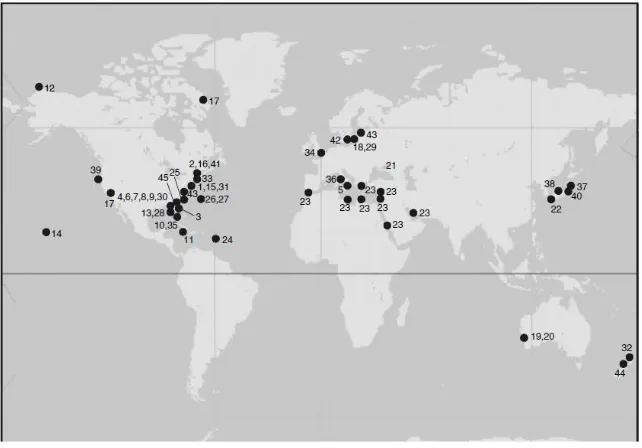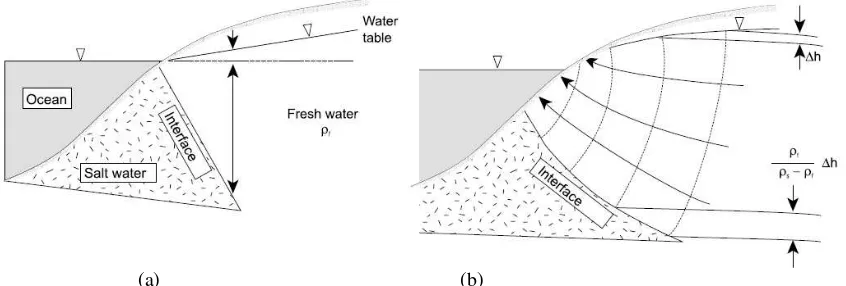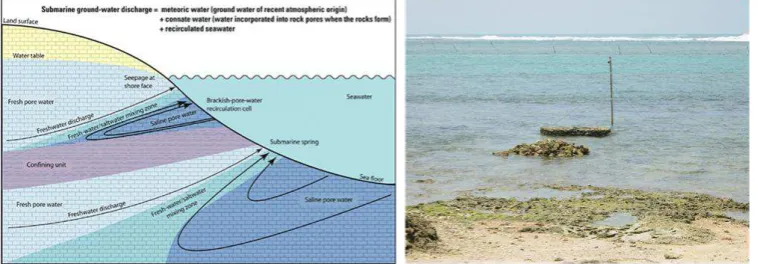Lubis, Rachmat Fajar, et.al / Riset Geologi dan Pertambangan Vol. 21 No. 1 (2011), 57-62.
57
SUBMARINE GROUNDWATER DISCHARGE (SGD)
IN INDONESIA
Rachmat Fajar Lubis, Hendra Bakti and Ade Suriadarma
ABSTRACT
Pulled by gravity, fresh groundwater will come in contact with seawater at the downstream end of its flow system. Most previous work has discussed the shape of the seawater/freshwater interface on the basis of Ghyben-Herzberg’s law. The groundwater, however, will come out to the surface as coastal springs or predicted by the law, the freshwater also can flow out from the bottom of the sea. The event of freshwater flows from the bottom of the sea or submarine is named submarine groundwater discharge (SGD). The analysis shows that the freshwater flows discharges along the interface, even as a submarine springs. Submarine groundwater discharge (SGD) is now recognized as an important pathway between land and sea. The understanding of SGD will facilitate the development of water resources and the evaluation of environments. This paper reviews the scientific significance of SGD evidence in Indonesia. It is concluded that while the SGD process is essentially ubiquitous in Indonesia coastal areas, the assessment of its characteristic should be made base on geology and hydrogeological condition. SGD estimation has been made in 6 locations,Naskah masuk : 3 Januari 2011 Naskah diterima : 20 April 2011
Rachmat Fajar Lubis
Pusat Penelitian Geoteknologi LIPI
Kompleks LIPI, Jl. Sangkuriang Bandung 40135 Email : fajarlubis@geotek.lipi.go.id
Hendra Bakti
Pusat Penelitian Geoteknologi LIPI
Kompleks LIPI, Jl. Sangkuriang Bandung 40135 Email : hendra.bakti@geotek.lipi.go.id
Ade Suriadarma
Pusat Penelitian Geoteknologi LIPI
Kompleks LIPI, Jl. Sangkuriang Bandung 40135 Email : adesuriadarma@yahoo.com
where this kind of research was the first time conducted in Indonesia.
Keyword: submarine groundwater discharge,
springs, fresh water, coastal, Indonesia
ABSTRAK
Mengikuti kontrol gaya gravitasi,airtanah akan mengalir menuju titik terendah dan pada beberapa lokasi akan mengalami kontak dengan air laut pada akhir sistem luaran aliran. Pada penelitian terdahulu, bentuk kontak ini telah seringkali dibahas berdasarkan hukum Ghyben-Herzberg. Mengikuti hukum fisika, airtanah dapat keluar di tepi pantai, lepas pantai atau didasar laut. Keluaran inilah yang secara terminologi dapat disebut sebagai keluaran airtanah di lepas pantai (SGD). Dari analisis keluaran airtanah di lepas pantai ini, terlihat bahwa keluaran ini memiliki beberapa bentuk seperti rembesan dekat pantai, rembesan aliran airtanah dan mataair lepas pantai. Keluaran inipun merupakan jalur penghubung yang penting antara interaksi airtanah dan air laut. Pemahaman keluaran airtanah di lepas pantai ini akan sangat membantu untuk permasalahan potensi pencemaran pantai, sumber nutrisi untuk wilayah lepas pantai dan alternatif kebutuhan akan air bersih. Makalah ini membahas tentang bukti ilmiah keberadaan keluaran airtanah di lepas pantai Indonesia. Hasil penelitian menunjukkan bahwa proses keluaran airtanah dilepas pantai tersebar di berbagai wilayah pesisir Indonesia. Penilaian karakteristik dan besarannya di masing-masing lokasi memerlukan berbagai teknik yang berbeda tergantung pada kondisi geologi dan hidrogeologi keluaran tersebut. Pengamatan secara detail telah dilakukan di 6 lokasi, dimana penelitian ini adalah pertama kalinya dilakukan di Indonesia.
Kata Kunci : Keluaran airtanah di lepas pantai,
58
Figure 1. Forty five (45) locations where submarine groundwater discharges have been reported (Taniguchi, 2002)
INTRODUCTION
Groundwater springs on the sea-floor have rarely been an object of study. Most researches focused on onshore seawater/freshwater interfaces, particularly regarded the saltwater intrusion in plan view (the salinization of groundwater). However, groundwater discharged from the sea-floor has recently been regarded as a natural resource, resulting in the initiation of groundwater flow studies including the shape of seawater/freshwater interfaces.
Pulled by gravity, fresh groundwater will come in contact with seawater at the downstream end of its flow system. Most previous work has discussed the shape of the seawater/freshwater interface on the basis of Ghyben-Herzberg’s law. The groundwater, however, will come out to the surface as a coastal springs or as predicted by the law, the freshwater also can flow out from the bottom of the sea. The event of freshwater flows from the bottom of the sea or submarine is named submarine groundwater discharge (SGD).
According to the compilation of observed SGD data over the world by Taniguchi et al (2002), 45 locations of specific SGD estimates shows that there is many independent studies have been performed on the east coast of the United States (US), Europe, Japan, and Oceania. Fewer studies have been done on the west coast of the US and Hawaii, and wide areas of the world (South America, Africa, southern Asia) have little to no SGD assessments at all (Figure 1).
Understanding SGD is important not only as a component of the general water cycle and a potential resource, but also to coastal environmental management where undesirable contaminants in groundwater can be discharged into the near-shore marine environment and disturbed the nutrient budgets of coastal water (Umezawa, 2009). The process of SGD can be reviewed from the following perspectives: (i) the global water cycle; (ii) assessment of the magnitude of the process via direct measurements, modeling and calculation: (iii) spatial and temporal variations of SGD; and (iv) importance to the nutrient budgets of coastal waters (Burnett, 2000). The objectives of this study are to overview the distribution of SGD, and reviews the scientific significance of SGD evidence in Indonesia.
Nature of the seawater/freshwater interface
Lubis, Rachmat Fajar, et.al / Riset Geologi dan Pertambangan Vol. 21 No. 1 (2011), 57-62.
59 (a) (b)
Figure 2. Shape of freshwater/seawater interface, (a) Ghyben-Herrzberg interface and (b) actual interface in the condition of flowing groundwater (Marui, 2003 after Bower, 1978)
Groundwater flow is determined by hydraulic gradient and hydraulic conductivity. As long as the interface is approximated by the
Ghyben-Herzberg’ equation, the true flow rate of
groundwater cannot be obtained. In order to obtain an exact flow rate, it is necessary to know the exact distribution of pore pressure in the rock formation, as proposed by Freeze and Cherry (1979). This requires capturing the exact shape of the interface between salt water and freshwater, for example by drilling boreholes normal to the coastline to observe the depth of the interface, as in the study of the shape of seawater/freshwater interface by Kohout (1964). However, this method is rarely feasible due to financial and logistic obstacles (Marui, 2003). Even if several observation wells are made, pumping of groundwater after the completion of the wells results in moving up onto the onshore side of the seawater/freshwater interface that was below the sea as reported by Reilly and Goodman (1987), or the injection of freshwater as drilling slurry may disturb the interface around the boreholes (Rubin and Pistiner, 1986).
SGD in Indonesia
The importance of the role of SGD also can be found in Indonesia. Although the number of SGD observations is very limited on a global scale in Indonesia, there are 6 locations founded (Table.1 & Figure 3). In order to indicate the SGD in the area studied, it was significant using groundwater discharge estimates methods such as visual
observation, seepage meters, flowmeters and geochemical tracers such as salinity (Lee, 1977). It is significant that many SGD measurements have been made in or mix within limestone or karst areas. Also most of the submarine groundwater discharges (SGD) occur where the hydraulic conductivity of the aquifers is large and thus significant amounts of groundwater discharge are expected under reasonable hydraulic gradients. Submarine groundwater discharge can occur from confined and unconfined aquifers. Discharge from confined aquifers can take the form of submarine springs and can occur at some distance from the shoreline, even at the shelf break. Potentiometric head can be visualized as the difference in elevation between the recharge and discharge zones of the source aquifer (Taniguci and Fukuo, 1993).
60
Typical Hydrogeology Flow rates
1. Karnaval Beach
-2. Binuangeun-Banten Flowmeter 0.3 25 Nearshore
Seepage Limestone 0,006 l/sec
3.
Springs Limestone tbi
5. Sempu Island, Jawa
Timur Flowmeter 0,6 0,5
Nearshore
Seepage Limestone 1,6 & 2,3 l/sec
6. Tanah Lot- Bali Visual-tbi 0 125 Nearshore
Seepage Limestone tbi
Lubis, Rachmat Fajar, et.al / Riset Geologi dan Pertambangan Vol. 21 No. 1 (2011), 57-62.
61 Figure 4. Schematic depiction of seepage at shore face associated with SGD, formed by limestone, no scale
(Swarzenski et.all, 2004) (left) and its example at Binuangeun, Banten-Indonesia (right)
Figure 5. Schematic depiction of seepage flow processess associated with SGD formed by sediment or volcanic fan deposit, no scale (Taniguchi, 2002) (left) and its example at Karnaval Beach, Jakarta (right).
Figure 6. Schematic depiction of submarine springs associated with SGD formed by limestone, no scale (Swarzenski et.all, 2004) (left) and example at Bulagi, Banggai Archipelago (Photo courtessy of Kumoro Y, koleksi pribadi) (right).
Nearshore groundwater seepage
Seepage at shore face was dominated by unconfined aquifer. The hydrogeology control type formed by limestone. For an example, it can be shown at Sempu Island, East Java,Tanah Lot, Bali and Binuangeun, Banten (Figure 4)
Groundwater seepage flow
Groundwater seepage flow can be occured from confined or unconfined aquifer. Hydrogeologically controlled type formed by sediment or volcanic fan deposit. For example, groundwater seepage flow shown at Karnaval beach, Jakarta (Figure 5).
Submarine freshwater springs
62
CONCLUSIONS
It is concluded that the SGD process is essentially ubiquitous in Indonesia coastal areas. Therefore assessment of its magnitude at any location term. A compilation of all available observed data shows that SGD in Indonesia can be generally classified as 3 typologies classification.
Additional data collection needs to obtain, especially database and applied such a variety of investigation methodology are necessary to integrate SGD knowledge in Indonesia. Parameters concerning geology, precipitation, vegetation (land use), and topography are the necessary main factors for SGD estimates. Inclusion/exclusion of recirculated seawater in SGD estimates depends on the scale and the purpose of the study. It is highly recommended that future studies will specify the inclusion/exclusion of recirculated seawater in SGD inputs. Comparisons between observed SGD and modelled/calculated SGD are also needed. This is not only for validating the modelling that includes previous global estimates, but also for estimating recirculated water. A continental-scale hydrogeological model that includes heterogenity of the aquifer may be needed to estimate the SGD potential aspects. In conclusion, SGD should be studied more with regard to water and dissolved material budgets at the local and global scales. This research will enrich the knowledge of groundwater-sea water interaction near the coastal area and it is the first time conducted in Indonesia.
ACKNOWLEDGMENTS
We are grateful to Dr. Robert Delinom as the Managing Editor and the reviewer for his thorough and helpful reviews of the manuscript. We are indebted to Igna Hadi S, Yugo Kumoro and Wilda Naily (Research Center of Geotechnology, LIPI) for their cooperation and useful suggestions.
REFERENCE
Bouwer H, 1978. Groundwater Hydrology. McGrawhill, New York.
Burnett, W.C., Taniguchi, M. and Oberdorfer, J.A. (2000). Assessment of submarine groundwater discharge into the coastal zone,
Journal of Sea Research..
Freeze R. A. and Cherry J. A. 1979; Groundwater. Prentice Hall, Englewood Cliff.
Kohout F. A., 1964. Submarine springs, in Encyclopaedia of Oceanography. Reinhold, New York: 878–883.
Lee, 1977. A device for measuring seepage flux in lakes and estuaries, Limnology and Oceanography, V22 (1), p 140-147.
Marui A, 2003. Groundwater conditions along the seawater/freshwater interface on a volcanic island and a depositional area in Japan. Geological Quarterly, 47 (4): p. 381-388. Reilly T. E. and Goodman A. S., 1987. Analysis
Swarzenski, P.W., J. Bratton, and J. Crusius, 2004. Submarine groundwater discharge and its role in coastal processes. USGS Open-File Report 2004-1226.
Taniguchi and Fukuo, 1993. Continuous measurements of groundwater seepage using an automatic seepage meter, Groundwater, Vol.31 No.4, p 675-679.
Taniguchi M, Burnett. W.C, Cable J.E, Turner J.V, 2002. Investigation of Submarine Groundwater Discharge. Hydrological Processes 16 Wiley Interscience, p 2115-2129.


